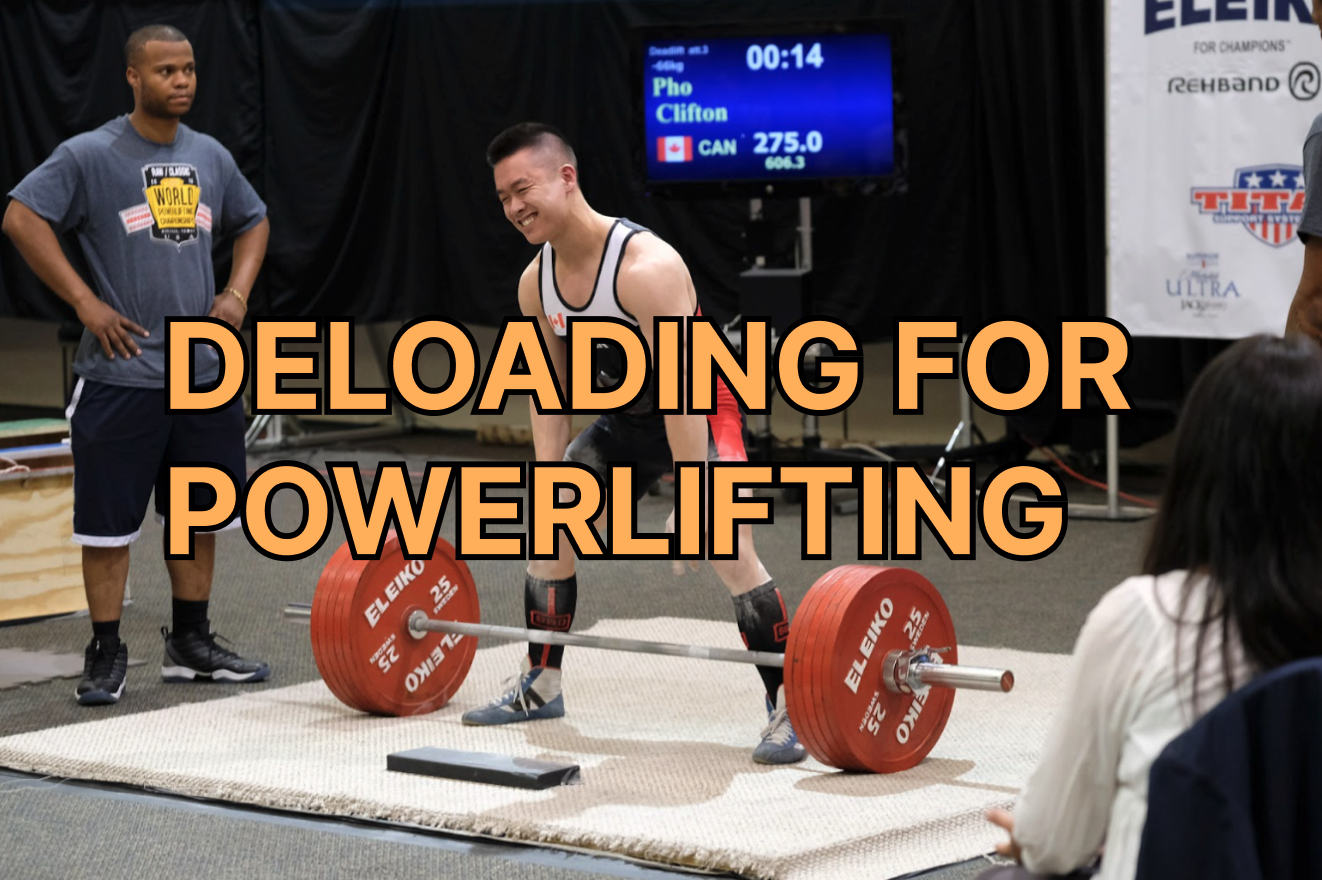How to Deload for Powerlifting
Written by The Boostcamp Editors
Mastering Deload for Powerlifting: The Ultimate Guide
Maybe you just failed your set, maybe you’re feeling extra fatigued, or perhaps you have a competition on the horizon. In all cases, you’ll want to learn more about how to deload and what that exactly can do for you. A deload is absolutely essential to throw in your training routine, especially for powerlifting. In this article, we’ll explore everything you need to know when it comes to a powerlifting deload.
Table of Contents
What is a Deload
How Do You Deload?
When should you Deload?
Planned VS Unplanned Deloads
Factors That Influence Your Deload
Conclusion - One Step Back, Two Steps Forward
What is a Deload?
A deload refers to a period of training where you purposely pull back on your training, but it’s more than just taking an easy week. The goal of a deload period is to promote extra recovery but still maintain your fitness so that you can inevitably be stronger when it counts. When you deload, you reduce the stress that is placed on your body from training temporarily. This period of lowered stress gives your body the time and resources it needs to recover. However, to the uninitiated outsider, deloads may seem like a waste of time or an excuse to sit on your butt for a week, watching TV instead of hitting the gym and shifting some heavy lumps of iron.
To deload, you simply reduce either the intensity (weight) or volume (sets and reps), including the number of reps. What you choose to reduce will be dependent on your goals and your personal circumstances. In general, If you are in season and prepping for a competition you will want to deload volume and keep the intensity high. Otherwise, if you are in the offseason, you likely want to deload intensity and maintain volume. Of course you can mix and match these two variables, but the key here is to reduce your overall workload from what you were currently doing. How much you reduce your workload is different for everyone, so it’s best to try manipulating one variable at a time to see how you respond.
Here are some examples of how your deload week might look.
Normal Training Week
3*5 Squat @ RPE 8 or 80% 1RM
3*8 Bench @ RPE 8 or 80% 1RM
3*5 Deadlift @ RPE 8 or 80% 1RM
Deload Training Week (intensity)
3*5 Squat @ RPE 7 or 75% 1RM
3*8 Bench @ RPE 7 or 75% 1RM
3*5 Deadlift @ RPE 7 or 75% 1RM
Deload Training Week (volume)
2*5 Squat @ RPE 8 or 80% 1RM
2*8 Bench @ RPE 8 or 80% 1RM
2*5 Deadlift @ RPE 8 or 80% 1RM
Deload Training Week (mixed)
3*5 Squat @ RPE 7.5 or 77% 1RM
2*5 Deadlift @ RPE 7 or 75% 1RM
You may also deload by changing the exercise itself as this would effectively lower your overall training stress. Here’s an example of what your training weeks might look like when doing this:
Deload Training Week
3*5 Long Pause Squat @ RPE 8 or 80% 1RM
3*8 Feet up Bench @ RPE 8 or 80% 1RM
3*5 Tempo Deadlift @ RPE 8 or 80% 1RM
Despite the sets, reps, and intensity being the exact same in both weeks, the variations implemented will force you to use less load. This type of deload can be particularly helpful when transitioning to new blocks to prepare you for the next one.
Don't know what RPE is? Read the full guide on RPE for lifting.
Deload for Powerlifting on Boostcamp App
If you’re using Boostcamp, you’ll notice many powerlifting programs have deloads integrated within the workout plan itself. We’ll touch on the nuances between planned and unplanned deloads later, but here are some examples of Boostcamp programs that incorporate a deload.
TSA Beginner Approach - This is an excellent 9-week program for beginners with a built-in deload at week 5. Check out the program for yourself:
https://www.boostcamp.app/bryce-lewis/tsa-beginner-approach

RAVAGE - This is a 10 week program with a 6 day workout split for intermediates who want to focus on hypertrophy. It also incorporates a deload at week 5. You can view the program here:
https://www.boostcamp.app/geoffrey-schofield/ravage
There are many popular and proven programs on Boostcamp without built-in deloads. For these programs, you can deload by using the Start Empty Workout function in the app to create a custom week of workouts and use one of the suggested deload formats.
When Should You Deload for Powerlifting?
Now that you know what a deload is, you’re probably wondering when you should deload. You can essentially deload whenever you feel the need to, but here are some cases where you might want to prepare for one specifically.
Prepping for competition
If you have a competition coming up, even if it is bodybuilding, you want to maximize your performance on that given day. To ensure your performance is there, you will want to deload prior to the meet to ensure you are properly recovered. Most programs have you deloading anywhere from 3-6 weeks out leading into the meet, followed by a small taper (which is also a form of deload) in the final days leading into the competition. This will be when fatigue has surpassed your ability to recover, or when you have reached peak performance without the ability to continue your progression. Powerlifters or weightlifters may also use a deload week, in the form of a taper week, prior to a competition to maximize performance on the day they compete.
After a competition
Similarly, you will want to deload after a competition to give yourself time to recover before you hit the weights again. A powerlifting competition is an extremely long day and places a lot of stress on your body. Not to mention the fact that you just spent the whole day maxing out your squat, bench and deadlift. You’ll thank yourself later for taking it slow and easing back into training.
Your performance has been decreasing or plateaued
Highs and lows are part of the process when it comes to strength training, but if you find you are constantly coming up short at the bar, you may want to consider a deload. Having a period of reduced training volume or intensity can be the change you need to break through this training slump.
You have been feeling more tired than usual
Feel like you’re low on battery? Sluggish and lacking motivation? It might be a sign that you need to deload. No matter how strong you are, you will inevitably need a break from training. If you are finding it hard to muster up the energy to go to the gym, or perhaps even struggling to stay awake at work, a deload can help you get your energy levels back to normal. However, if you are experiencing sore joints and a lack of motivation, it could be a clear indication that you need to incorporate a deload week into your training routine.
You are moving into a new block
Sometimes after a competition, or after a block of training you may be moving into a new direction for your training. Perhaps you want to push some volume, or incorporate some new movements you have never done before. A deload can help prepare you for this new block as it is a perfect time to try new things. This can sometimes be referred to as a pivot block. If you want to learn more about deloads or programming in general, shoot us a DM on Instagram.
When it fits your lifestyle
Going on a vacation? Busy with a new job? Perhaps you got sick? It might be the perfect time to plan a deload. Believe it or not, there is more to life than the gym. If you have plans or sudden events that may interfere with your training, it’s ok to do less and a deload may be the best thing for you. Trust me, you won’t lose all your gains from taking some time off.
How Long do Deloads Last?
Another consideration is how much time you should spend deloading. Most traditional deloads are around a week or two in length. A good rule of thumb is to use no more than a third of your overall training block to dictate how long you should deload for. For example, if you trained for six weeks, you can allow up to a two week deload. If you have trained for four weeks, a one week deload should suffice. Remember that you want to promote recovery while maintaining performance, so when reaching the end of a deload you should be feeling more recovered but still ready to get back into training. Typically, deload weeks are recommended every 8-to-10 weeks of hard training.
If you find you’re still feeling fatigued, you may want to deload longer, or further decrease the overall intensity and volume. If you find you’re feeling extra rusty after a deload, you may want to shorten the deload, or minimize how much you pull back the intensity and volume.
Now there is no exact science when it comes to planning deloads, but first thing's first, you’ll notice some programs do have built-in deloads periodically. The community is quite divided as some people swear by structured deloads and others do not. Like all things it is always a trade off, but here are some pros and cons along with some tips on when you might want to utilize each one.
Pros of a Planned Deload
Predictable and consistent: You know when your next deload is, and you now have a clear target of when you will pull back your training.
Easy to follow and program: With planned deloads, you don’t have to stress about how long your blocks of training are. It is on an easy to follow schedule and allows you to plan your life accordingly.
Potentially reduces risk of injury: A regular deload means planned recoveries which can reduce the risk of injury.
Cons of a Planned Deload
Can halt progress: Sometimes your training might be going very well, but if the next week is a deload, it will stop your momentum. Having this deload week in advance could potentially slow your progress by prematurely cutting your gains short.
Rigid: Life isn’t always as planned, so you may find it harder to modify your training on a rigid schedule. What if you need to leave suddenly on a trip halfway into a block? It’s a lot harder to modify on the fly when everything is preplanned.
Unplanned Deload Pros
Reactive in nature to performance: Unplanned deloads on the other hand are really good for listening to your body and adapting accordingly. If you feel great, then you can continue training. If you feel bad then you can consider a deload.
Can allow new training data and strategies to emerge: With the flexibility that comes with a reactive strategy, you may find more optimal strategies for your training that you normally would never venture into. Maybe you’re feeling a little tired on week six and you would typically pull back your training but suddenly on week eight you have major gains. This finding would not be possible if you had a deload scheduled in advance.
Good teaching tool: Unplanned deloads can help you learn more about your body and how you respond to training. It can also help you distinguish better between your subjective feelings (such as how heavy the weight feels) and objective findings (such as bar speed) when it comes to training.
Unplanned Deload Cons
Harder to implement: Due to the nature of being reactive, it typically involves more effort. You really have to be in tune with your body and program while ensuring you are not just being lazy when you feel the need to deload.
Unpredictable and Inconsistent: Unlike the planned deload, you don’t know when your next break is which can be tough for some people. It might be in three weeks, or maybe not until two months later.
Higher chance of overtraining: As you train for longer without a break, you run a higher risk of overtraining and potentially injury. Of course, this can happen regardless of how you train, but pushing progress can be addicting and lead to unwanted outcomes if you don’t know when to pull back. Heavy weights and lots of sets and reps over weeks of training beat you up, increasing the likelihood of getting hurt.
When and How to Use Planned Deloads
If you have an event in mind such as a competition, a planned deload the following week is the way to go. With a rigid schedule, you want to make sure you have a plan to prepare you for gameday. The only lifts that count are the ones you perform on the platform. A structured deload can help achieve those elusive three white lights. Try to plan your deload anywhere from three to six weeks out from your competition to maximize your game day performance.
Tip: You can choose a Boostcamp Program with a block that perfectly aligns with your timeframe to competition.
When and How to Use Unplanned Deloads
If you’re training in the offseason, you can afford to have a few weeks of extra fatigue. This can allow you to make more progress whereas a planned deload may cut into that early. Try to have measures such as an overall session RPE (Rating of Perceived Exertion) and/or barspeed (you will need a tendo unit) to track when you might want to take a break. If these measures are dropping consistently over a couple weeks in multiple training sessions, it might be time for you to deload and address any aches that may have developed.
Tip: Some Boostcamp Programs easily allow you to track your bar speed and RPE during your workout. You can look back on this data to see how your performance has been trending which can help you evaluate if you need to deload.
Factors That Influence Your Deload
Your body is more than just muscles and bones. The external load on the bar matters greatly when it comes to performance and recovery, but you cannot forget about other factors in your life that can influence the weight you load on the bar.
Sleep
Before you jump onto the deload train, take a look at your sleep schedule. Lacking quality sleep can severely impact your performance (1). Some changes on this end may be all you need to continue making progress. Practicing good sleep hygiene can help but if necessary, don’t be afraid to seek help from a professional if you have issues sleeping.
Stress
Are you going through a particularly stressful time in your life? This can impact your performance as well (2). Try working out after working 20 hours overtime, or if you have a final exam/big project due tomorrow. More often than not you’ll notice you’re not on your A - game. You may not be able to avoid the stress but control what you can and spend some time managing your stress appropriately. Don’t worry, the gym will still be there waiting for you.
Nutrition
Training on an empty stomach? Without energy, things can feel extremely sluggish, almost as if someone turned the gravity up. Take an honest look at how you are fueling your body, and make sure you’re getting enough calories in.
Of course there are more factors than this, but if you don’t consider these things, no amount of deloading will help you get back on track. On the other hand, if you are seeing some of these warning signs both in and outside of the gym, such as sore joints, it could be a sign that you need to deload.
Why not Just Take a Week Off?
You might be wondering.. Why not just take a week off? You definitely can, and in some cases it may be the right move. However, if you want to maintain your performance, it is always better to try to stay active. They say motion is lotion, and maintaining some level of fitness even during a deload will help you bounce back quicker than taking a complete week off training. Additionally, it's important to remember that during a deload, certain tissues in the body, such as tendons, ligaments, and bones, require more time to heal compared to muscles.
Conclusion - One Step Back, Two Steps Forward
So there you have it, that is everything you need to know about a powerlifting deload. There are many strategies to deload but the key is to reduce your overall workload to better prepare you for future training/competitions. A deload is key in any sport, and can help unlock your performance for gameday. Sometimes you have to do less in the moment, to ensure future progress in the sport of powerlifting. Additionally, implementing these principles within your own training can optimize your strength gains!
Be sure to follow Boostcamp on Instagram and subscribe on YouTube!

References
Charest J, Grandner MA. Sleep and Athletic Performance: Impacts on Physical Performance, Mental Performance, Injury Risk and Recovery, and Mental Health: An Update. Sleep Med Clin. 2022 Jun;17(2):263-282. doi: 10.1016/j.jsmc.2022.03.006. PMID: 35659079.
Lopes Dos Santos M, Uftring M, Stahl CA, Lockie RG, Alvar B, Mann JB, Dawes JJ. Stress in Academic and Athletic Performance in Collegiate Athletes: A Narrative Review of Sources and Monitoring Strategies. Front Sports Act Living. 2020 May 8;2:42. doi: 10.3389/fspor.2020.00042. PMID: 33345034; PMCID: PMC7739829.

